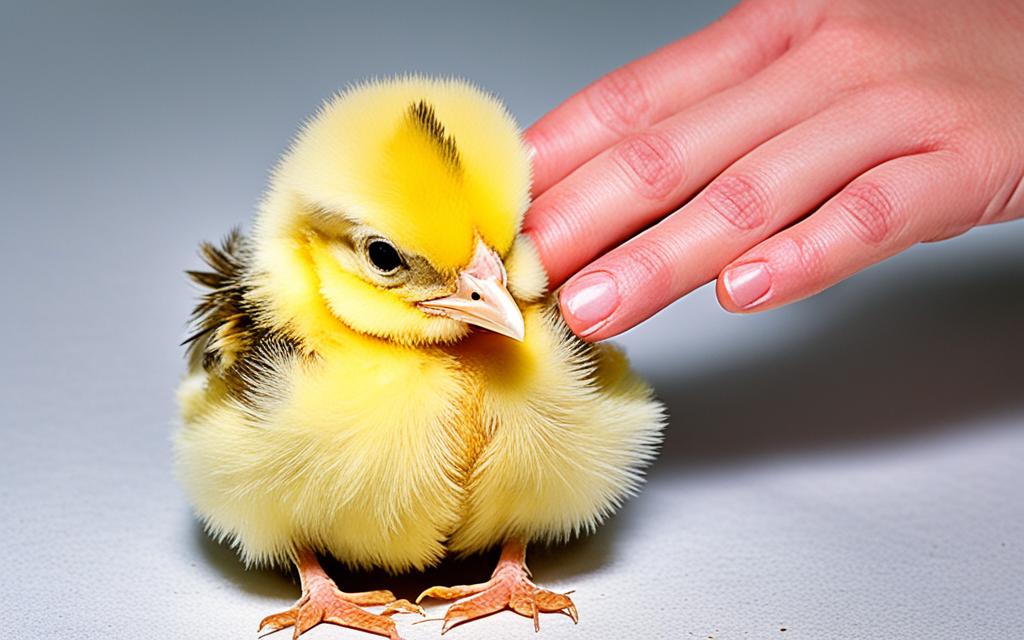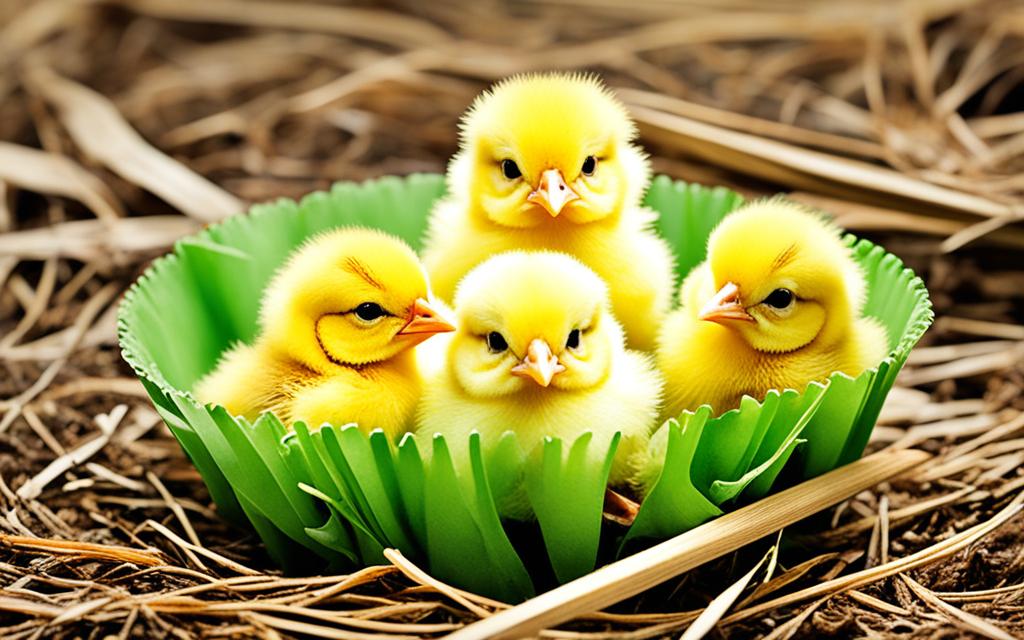In this section, we will discuss the crucial warning signs that indicate a baby chick is in distress and may be dying. By recognizing these signs early on, you can take immediate action to save the chick’s life.
Losing a baby chick can be a heartbreaking experience for any poultry owner. However, by understanding the signs of a dying chick, you can intervene and provide the necessary care to improve its chances of survival.
It’s important to know that not all baby chicks showing these signs will ultimately die, but these indicators should be taken seriously and used as a prompt to seek veterinary assistance or provide appropriate interventions.
Key Takeaways:
- Recognizing the signs of a dying chick is crucial for taking immediate action.
- Physical changes, respiratory distress, and unusual behavior are common warning signs.
- Changes in feeding habits, weakness, and abnormalities in fecal matter should be monitored.
- Eye and beak abnormalities, along with skin and feather issues, can be indicative of underlying health problems.
- If you notice any of these signs, seek veterinary care or consult an expert for assistance.
Observing Physical Changes
When it comes to the health of baby chicks, observing physical changes is crucial. These changes can serve as indicators of their overall well-being and help identify any potential issues. In this section, we will explore some common physical indicators that can suggest a baby chick’s health status.
Weakness
One of the first signs that a baby chick may be in distress is evident weakness. If you notice the chick struggling to move, stand, or keep up with its peers, it could be a cause for concern. Weakness may indicate underlying health issues that require attention.
Lack of Appetite
Another significant indicator of a dying chick is a sudden loss of appetite. If a baby chick shows no interest in eating or drinking, it may be a sign of an underlying health problem. Monitoring their feeding habits can provide valuable insights into their overall health.
Abnormal Stool
Changes in stool consistency, color, or frequency can also be an indication of a baby chick’s health condition. Pay attention to any abnormality in their droppings, such as diarrhea, blood in the stool, or changes in color. These signs should not be ignored and require further investigation.
Changes in Body Temperature
Body temperature plays a vital role in the well-being of baby chicks. If you notice significant changes in their body temperature, such as unusual warmth or coldness to the touch, it could be a sign of an underlying health issue. Monitoring their body temperature can help you identify potential problems and take appropriate action.
Being attentive to these physical changes in baby chicks can help ensure their well-being and prompt intervention when needed. Remember, early recognition and proper care are essential in preventing further deterioration and saving the lives of these vulnerable creatures.
Respiratory Distress
Respiratory issues can be alarming and indicate a serious health problem in baby chicks. It’s important to be aware of the symptoms that may signal respiratory distress. This section will discuss the specific warning signs to look out for, including:
Coughing
Coughing is a common symptom of respiratory distress in chicks. It may manifest as a repetitive, dry, or raspy cough. If you notice your chick coughing frequently, it could indicate an underlying respiratory issue.
Sneezing
Sneezing is another telltale sign of respiratory distress in baby chicks. Just like humans, chicks may sneeze to expel irritants from their respiratory passages. If your chick is frequently sneezing or has a runny nose, it’s essential to monitor its condition closely.
Labored Breathing
Labored breathing is a red flag that your baby chick may be experiencing respiratory distress. You may notice the chick struggling for breath, with rapid or shallow breathing. If the chick’s chest is visibly heaving or if it sounds like it’s struggling to breathe, immediate intervention is necessary.
Nasal Discharge
Excessive nasal discharge is a concerning symptom that suggests respiratory distress. The presence of mucus or discharge around the chick’s nostrils can indicate an infection or blockage in the respiratory system. It’s crucial to take prompt action to address the underlying issue and prevent further complications.
Recognizing these symptoms early on can help you identify respiratory distress in baby chicks and take the necessary steps to ensure their health and well-being.
| Signs of Respiratory Distress in Baby Chicks | Description |
|---|---|
| Coughing | A repetitive, dry, or raspy cough |
| Sneezing | Frequent sneezing or runny nose |
| Labored Breathing | Rapid or shallow breathing, visible heaving of the chest |
| Nasal Discharge | Excessive mucus or discharge around nostrils |
Unusual Behavior Patterns
While physical symptoms are often the first indicators of a sick chick, changes in behavior can also provide valuable insights into its health condition. When observing your baby chicks, keep an eye out for any unusual behavior patterns that may signal a declining state of health. Here are some common signs to watch out for:
- Lethargy: A dying chick may display extreme tiredness and a lack of energy. It may appear weak and find it difficult to move or interact with its surroundings.
- Isolation from the flock: If a chick begins to isolate itself from its siblings or avoid social interactions, it could be a sign of distress. Healthy chicks typically prefer to stay close to their flockmates.
- Excessive sleepiness: While chicks do sleep, an abnormally high amount of sleepiness can be concerning. If a chick is spending most of its time sleeping and not engaging in normal activities, it may be an indication of illness.
- Decreased responsiveness: A sick chick may become less responsive to its environment or the presence of humans. It may not react to stimuli or show interest in food, water, or interaction.
It’s important to note that these behavior patterns can vary depending on the individual chick and the severity of its condition. If you notice any of these signs, it’s crucial to take prompt action to ensure the chick’s well-being.
To further illustrate the signs of a dying chick, refer to the table below:
| Behavior Patterns | Significance |
|---|---|
| Lethargy | May indicate weakness and lack of energy |
| Isolation from the flock | Suggests distress and potential illness |
| Excessive sleepiness | Can be a sign of abnormal lethargy and illness |
| Decreased responsiveness | May indicate a lack of interest in food, water, or interaction |
Changes in Feeding and Drinking Habits
A baby chick’s appetite and water intake are crucial indicators of its overall health. Monitoring their feeding and drinking habits is essential in identifying potential health issues and ensuring their well-being. Here are some signs to look out for:
Poor Feeding
If you notice that a baby chick is not showing interest in food or eating significantly less than usual, it could be indicative of underlying health problems. Poor feeding can manifest as:
- Refusing food or pecking at it without consuming an adequate amount
- Significant weight loss or slower growth compared to other chicks
- Weakness or lethargy
It is essential to ensure that chicks have access to fresh and appropriate feed and monitor their consumption to promote their development and overall health.
Reduced Water Intake
Water is vital for a chick’s hydration and overall physiological functions. Inadequate water intake can indicate potential health issues and should be closely observed. Signs of reduced water intake may include:
- Less water in the chick’s drinker
- Dehydration symptoms such as dry and flaky skin
- Lethargy or weakness
Providing clean and fresh water is essential to meet their hydration needs and promote their overall health and well-being.
Difficulty Swallowing
Observe any signs of difficulty that chicks may have while swallowing their food or water. Difficulty swallowing may manifest as:
- Choking or gagging during eating or drinking
- Excessive shaking of the head or neck after consuming food or water
- Visible discomfort or distress during feeding
If you notice any of these symptoms, it is crucial to seek veterinary assistance promptly to address any potential health issues and ensure the chick’s comfort and survival.

Observing and responding to changes in a baby chick’s feeding and drinking habits can help identify potential health issues early on. By ensuring that their nutrition and hydration needs are met, you can support their growth and overall well-being.
Weakness and Limping
If you notice that a baby chick is displaying weakness or experiencing difficulty walking, it could be a sign of an underlying health issue. Weakness and limping are key indicators that something may be wrong with the chick’s health.
A weak chick may stumble, have trouble standing, or show decreased mobility compared to its siblings. This lack of strength and coordination can be a cause for concern and should be addressed promptly.
There can be several reasons why a baby chick might experience weakness or limping. It could be due to a nutritional deficiency, a genetic condition, or an injury. In some cases, weak or limping chicks might also be more prone to infections or diseases.
As a responsible caretaker, it’s crucial to observe the chick closely and monitor its behavior. If you notice signs of weakness or limping, it’s recommended to seek advice from a veterinarian who specializes in avian health. They will be able to provide a proper diagnosis and guide you on the appropriate course of action to support the chick’s recovery.
“It’s crucial to observe the chick closely and monitor its behavior. If you notice signs of weakness or limping, it’s recommended to seek advice from a veterinarian who specializes in avian health.”
Remember, early intervention can greatly increase the chances of a positive outcome for the chick’s health.
| Common Signs of Weakness and Limping in Baby Chicks | Possible Causes |
|---|---|
| Stumbling or difficulty walking | Nutritional deficiency |
| Inability to stand | Genetic condition |
| Decreased mobility | Injury |
| Predisposition to infections or diseases |
Changes in Fecal Matter
Abnormalities in a chick’s stool can be indicative of an underlying health problem. Paying attention to changes in color, consistency, and the presence of blood can provide valuable insights into the chick’s well-being.
Here are some signs to watch out for:
- Diarrhea: Loose or watery stool can be a sign of digestive issues or infection.
- Blood in the Stool: The presence of blood can indicate internal bleeding or intestinal damage. It is important to seek veterinary attention immediately.
- Changes in Color: If the chick’s stool suddenly changes color or becomes pale, it may indicate liver or intestinal problems.
- Unusual Consistency: Extremely watery or extremely hard stool can be a sign of digestive issues or dehydration.
Monitoring the chick’s fecal matter regularly is crucial for early detection of health problems. If you notice any of these abnormalities, it is recommended to consult a veterinarian experienced in poultry care for proper diagnosis and treatment.
| Abnormality | Possible Causes |
|---|---|
| Diarrhea | Infection, digestive issues, stress |
| Blood in the Stool | Internal bleeding, intestinal damage |
| Changes in Color | Liver problems, intestinal issues |
| Unusual Consistency | Dehydration, digestive issues |
Eye and Beak Abnormalities
The eyes and beak of a baby chick can provide important clues about its health. Paying attention to any abnormalities in these areas can help you identify potential health issues early on. Here are some common eye and beak abnormalities to watch out for:
- Swollen eyes: Swelling around the eyes may indicate an infection or injury.
- Crusty eyes: Crustiness or discharge around the eyes could be a sign of an eye infection.
- Discharge: Any unusual discharge from the eyes could indicate an underlying health problem.
- Beak alignment: A misaligned or crooked beak can make it difficult for a chick to eat and drink properly.
If you notice any of these eye and beak abnormalities in your baby chicks, it’s important to consult a veterinarian or an experienced poultry expert for further evaluation and guidance.
Expert Insight:
“The eyes and beak of a baby chick are vital indicators of its overall health. Any abnormalities or changes in these areas should be taken seriously and addressed promptly to ensure the well-being of the chick.”
– Dr. Emily Carter, Poultry Veterinarian
Skin and Feather Issues
One of the key indicators of a baby chick’s health is the condition of its skin and feathers. Changes in these areas can serve as warning signs of underlying health problems. By closely observing the chick’s skin and feathers, you can identify potential issues and take appropriate actions to support its well-being.
Here are some common skin and feather issues to watch out for:
Bald Patches
Noticeable bald patches on a baby chick’s body can indicate feather loss or abnormal feather growth. This symptom may be a sign of stress, nutritional deficiencies, or even an infestation of mites or lice. Prompt intervention is necessary to address the underlying cause and prevent further complications.
Flaky Skin
Flaky skin is another skin issue to look out for in baby chicks. It can occur as a result of dryness, inadequate humidity, or an imbalance in diet. Regularly monitor the chick’s skin for any signs of excessive dryness and adjust the environmental conditions as necessary to maintain optimal moisture levels.
Mites or Lice Infestation
A parasitic infestation by mites or lice can severely affect a baby chick’s overall health. These tiny creatures can cause discomfort, irritation, and even anemia. Watch for excessive scratching, restlessness, and the presence of tiny creatures on the skin or feathers. If you notice signs of infestation, consult a veterinarian for guidance on treatment and prevention.
Abnormal Feather Growth
Abnormal feather growth in a baby chick, such as misshapen or crooked feathers, can indicate genetic abnormalities, nutritional imbalances, or underlying health issues. This condition may compromise the chick’s ability to regulate body temperature or fly properly. It is crucial to identify the cause of abnormal feather growth and provide appropriate care to ensure the chick’s well-being.
| Causes | Symptoms |
|---|---|
| Stress | Bald patches or abnormal feather growth |
| Nutritional deficiencies | Bald patches or abnormal feather growth |
| Mites or lice infestation | Excessive scratching, tiny creatures on skin or feathers |
| Environmental factors | Flaky skin |
| Genetic abnormalities | Abnormal feather growth |
Remember, it is essential to promptly address any skin or feather issues in baby chicks to ensure their overall health and well-being. Seeking veterinary advice and implementing proper care practices can greatly improve their chances of survival and growth.

Conclusion
In this final section, we have explored the key warning signs that indicate a baby chick may be dying. By being vigilant and recognizing these signs, you can take prompt action to seek appropriate veterinary care or provide necessary interventions to save the chick’s life.
Signs such as weakness, lack of appetite, abnormal stool, changes in body temperature, respiratory distress, unusual behavior patterns, and changes in feeding and drinking habits are all important indicators of a chick’s health. Additionally, paying attention to signs of weakness and limping, changes in fecal matter, eye and beak abnormalities, and skin and feather issues can provide valuable insights into the chick’s overall well-being.
Remember, early detection is key in ensuring the health and survival of baby chicks. If you notice any of these signs or suspect that a chick is in distress, it is crucial to act promptly. Seek the assistance of a veterinarian who specializes in poultry care, or consult reliable resources for guidance on appropriate interventions to improve the chick’s chances of survival.
FAQ
What are the key warning signs that indicate a baby chick is dying?
The key warning signs that indicate a baby chick is dying include physical changes such as weakness, lack of appetite, abnormal stool, and changes in body temperature. Other signs include respiratory distress, unusual behavior patterns, changes in feeding and drinking habits, weakness and limping, changes in fecal matter, eye and beak abnormalities, and skin and feather issues.
What are some physical changes I should look out for in a baby chick?
Some physical changes to look out for in a baby chick include weakness, lack of appetite, abnormal stool, and changes in body temperature. These indicators can suggest that the chick is in distress and may be dying.
What are the symptoms of respiratory distress in baby chicks?
Symptoms of respiratory distress in baby chicks include coughing, sneezing, labored breathing, and nasal discharge. If you notice these signs, it is important to seek veterinary care as respiratory issues can be serious and potentially fatal for the chick.
What are some unusual behavior patterns that may indicate a chick is dying?
Unusual behavior patterns that may indicate a chick is dying include lethargy, isolation from the flock, excessive sleepiness, and decreased responsiveness. If you observe these signs in a baby chick, it is important to take immediate action to address its health concerns.
What are the changes in feeding and drinking habits that may signal a dying chick?
Changes in feeding and drinking habits that may signal a dying chick include poor feeding, reduced water intake, and difficulty swallowing. If you notice these signs, it is crucial to intervene promptly to provide the chick with the necessary care and support.
What are the signs of weakness and limping in a baby chick?
Signs of weakness and limping in a baby chick include stumbling, inability to stand, and decreased mobility. These symptoms can indicate underlying health problems, and it is important to address them to ensure the chick’s well-being.
What are some changes in fecal matter that may be concerning for a baby chick?
Changes in fecal matter that may be concerning for a baby chick include diarrhea, blood in the stool, and changes in color or consistency. If you observe these signs, it is important to seek veterinary advice as they could indicate serious health issues.
What are some eye and beak abnormalities to watch out for in a baby chick?
Some eye and beak abnormalities to watch out for in a baby chick include swollen or crusty eyes, discharge from the eyes, and problems with beak alignment. If you notice these abnormalities, it is advisable to consult a veterinarian for proper diagnosis and treatment.
What skin and feather issues should I be concerned about in a baby chick?
Skin and feather issues that may be concerning in a baby chick include bald patches, flaky skin, mites or lice infestation, and abnormal feather growth. If you observe these issues, it is important to address them promptly to improve the chick’s health and well-being.
How can I tell if a baby chick is dying?
You can tell if a baby chick is dying by observing the warning signs, such as physical changes, respiratory distress, unusual behavior patterns, changes in feeding and drinking habits, weakness and limping, changes in fecal matter, eye and beak abnormalities, and skin and feather issues. If you notice these signs, it is crucial to seek professional help or provide appropriate interventions to save the chick’s life.








